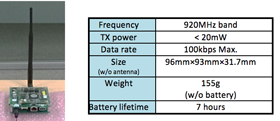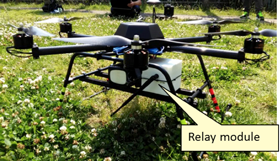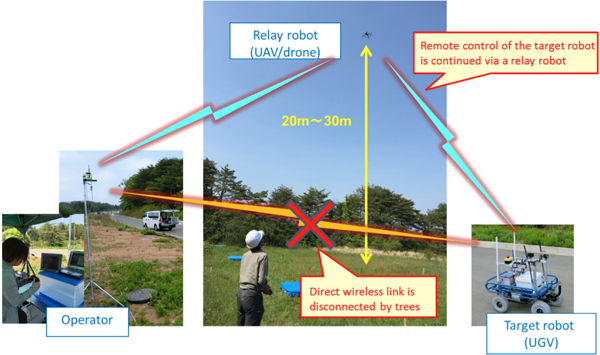The research group developed a layer 2-based wireless relay communication technology for the command/control and telemetry signals of a remotely-operated target robot out of the line-of-sight via other robots (
Fig. 1).
The technology enables continuous operation of a robot out of the line-of-sight with simultaneous and redundant transmission of command/control and telemetry signals via multiple relay routes through other robots. We reconstructed the communication scheme from conventional ones such as that of wireless LAN and realized a new one dedicated to robot control on a relay transmission basis. The new scheme also employs a time-division multiple access (TDMA) control protocol to share the communication media among different robot terminals with small response latency and low packet collision probability, which gives an efficient use of time resource and constant freshness of the command/control and telemetry data.
The conventional communication schemes, mainly designed for Internet access, mostly carry out search and calculation to select the best relay route to transmit data, assuming unspecified relay nodes with small mobility. The new scheme removes the above procedures and implements a simplified procedure in layer 2, where the target robot receives the command/control and telemetry data via all of the possible routes with different TDMA slots, assuming a small number of specified relay nodes with high mobility. The target robot simply selects a signal with the best quality among those signals. With this technique, the response latency through one relay robot has been improved to about 50 msec (*2), compared to that of conventional schemes, the latency of which varies from several 10 msec to several 100 msec depending on the communication traffic conditions. Moreover, our technology gives continuity of relay connection even with the frequent and random change of the relay route due to the movement of the robot, so that we can avoid momentary disconnection of the control link, which ensures the stability of the control of the target robot (*3).
Fig. 2 and
Fig. 3 show a series of prototypes of the wireless modules and the specifications, respectively, which uses 920 MHz band for both command/control and telemetry signals. NICT and AIST successfully demonstrated the validity of the technology by controlling a UGV in operation beyond the line-of-sight. A multi-rotor drone hovering at an altitude of 20-30m served as an aerial relay robot to connect the UGV to its operator. This is the first time that not only control of a UGV via a flying drone but also continuity of the connection even with the frequent and random change of the relay route was achieved in the world.
*2 This value is selectable by the priority between the response speed and the required data size.
*3 The time to change the relay route is also within 50 msec and the data loss is therefore minimized.



































































































































